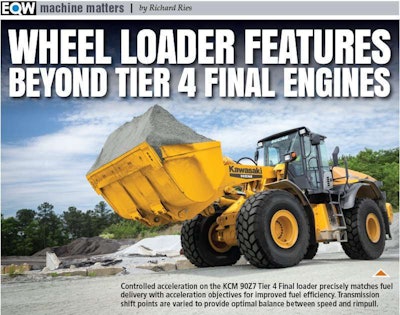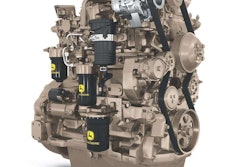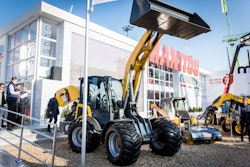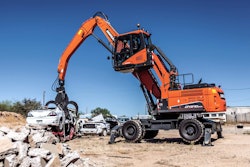
So what have wheel loader manufacturers been working on since Tier 4 engines and after treatment have been resolved?
We asked specifically about hydraulics, electronics and components. How have these areas been improved and how does that translate to value for the customer?
Hydraulics get efficient
In the past, manufacturers used fixed-displacement pumps. These run the same flow and same pressure all the time regardless of demand. The only way to change their performance is to vary input speed by varying engine speed. More speed, more flow. Less speed, less flow. When flow exceeds demand, the excess dumps over a relief valve. Fixed-displacement pumps are inexpensive, simple and provided quick response when a control valve is opened.

What about other factors? Because there’s no excess flow through a relief valve, the system runs much cooler. Initial cost is higher with variable-displacement pumps, but payback can come quickly depending on fuel cost and operating hours. Variable-displacement pumps are more complex than fixed-displacement pumps, but modern components give thousands of hours of service life before rebuild or replacement is required. Responsiveness has increased because pumps are integrated with the machine’s electronics; there’s no more delay in pump response to an electric signal than there is a light bulb’s response to an electric switch.
Variable-displacement pumps need input to know how much output to produce. The whole system is called load-sensing hydraulics. But while load-sensing hydraulics have become commonplace, they are not universal, says Eric Yeomans, product manager, Volvo Construction Equipment. “Customers should be aware that load-sensing hydraulics aren’t present in every manufacturer’s lineup.”
There is at least one holdout to using variable-displacement pumps: SDLG. They’ve positioned themselves in North America as a low-cost leader by offering machines with fewer frills, and their hydraulics reflect this. “Our open-center, fixed-displacement gear pump does carry a fuel penalty of up to 20 percent,” says SDLG sales manager Nick Tullo. “But there’s also 30-percent less cost in a new machine and 30-percent less cost at replacement.” Tullo says while many loaders see 2,000 operating hours per year, SDLG customers’ machines average half that. Half the hours means it will take twice the time to pay back in fuel savings using a more expensive variable-displacement pump. “And if customers want a fully-featured machine, we walk them over to the Volvo line.” SDLG and Volvo have a distribution, sales and service agreement in the U.S.

Controls for optional hydraulic features are typically integrated with standard controls. On Komatsu loaders with the optional third spool, for example, the operator uses the standard mono-lever to control the third spool by thumb. The third spool valve can be operated in either continuous or proportional flow mode.
Electronics make it easy
Electronics maximize modern hydraulic systems, including the ways those systems can be tailored to fit the demands of specific applications and the preferences of specific operators. Power and work modes, return-to-carry and return-to-dig are among the features available thanks to electronics.
At first these features were positioned as a way to enhance the performance of new operators, an especially compelling argument as the economy improved. Finding and keeping experienced operators became more challenging and contractors often had to hire less-skilled workers. But customers soon discovered that the benefits of electronic controls and features helped even seasoned operators increase their production and contractors with more advanced equipment were better able to attract and retain more advanced operators.
As electronics grew, so did the challenge of presenting information to operators in a way that made it easy for them to manage all the options. Improvements to in-cab monitors have helped. Case, for example, offers an eight-inch LCD monitor that gives information on such items as fuel levels, temperatures and pressure readings, trip information, maintenance reminders and machine diagnostics. The monitor also serves as the display for the optional integrated rearview camera and provides fingertip selection of operating modes and features such as Auto Idle and Auto Shutdown. Functions not accessed through the monitor are easier to use, too. Case has an automotive-style steering console with familiar controls for lights, wipers, and turn signals. A membrane keypad replaces an array of rocker switches for other machine functions.

Electronics make it easier for operators to do mundane tasks. Komatsu loaders have a remote boom and bucket positioner that will store three horizontal settings, allowing the operator to change attachments without resetting the bucket level. Automatic kickdown to first forward gear eliminates the need for the operator to manually downshift when entering the pile. “Making everyday tasks easier reduces fatigue and improves job satisfaction,” says Craig McGiniss, wheel loader product manager, Komatsu. “It’s as much a part of the improved operator environment as a quiet cab, high-capacity HVAC and comfortable seat.”
Use of telematics remains spotty. One complaint is the drinking-from-a-firehose syndrome of way too much information, all the time. Yeomans says Volvo now offers both CareTrack reports and ActiveCare monitoring service. “ActiveCare was designed to cut through the noise and deliver only information that matters to the contractor along. ActiveCare will also provide specific recommendations for actions so customers know what actions will deliver benefits to their machine, their fleet and their business.”
Hard parts doing hard work
In automotive parlance, hard parts are anything cast, machined, welded, etc. They include everything from pistons to door latches. Transmissions are quintessential hard parts, and transmissions have been updated to match advances in other areas.
Lock-up torque converters provide more torque for demanding applications and improved fuel efficiency in all conditions, but optimal performance requires careful control. Matching engine output to lock-up is one of the tasks assigned to Komatsu SmartLoader Logic. SmartLoader Logic tailors engine torque to machine demands throughout operations and using this feature to optimize lock-up was a logical extension of technology.

The adaptive clutch cutoff was also changed on K-II loaders. On previous models, it could be set to Off or one of three user-selectable positions. K-II machines make this decision automatically based on input from a wide range of sensors, including those for brake pedal pressure and throttle position. “Based on the data, the loader assumes an application,” says Matt Miller, 4WD loader product consultant at John Deere. “So, for example, it would give a later release when the machine is driving up a ramp to load a hopper than it would when the machine was operating on flat ground to load trucks.”
Caterpillar departed from conventional thinking in developing their XE technology a few years ago. Engine power is split into two paths, one mechanical and one hydraulic. The two paths converge at a set of planetary gears where the mechanical path functions much like a direct-drive transmission. The hydraulic path, by means of a variable-displacement pump, works as a hydrostatic transmission to assist the mechanical drive. The amount of assist provided is continuously variable and the net effect is basically a continuously-variable transmission (CVT), which eliminates the torque converter. This feature is available on the 966M XE and 972M XE.
Liebherr calls their split approach to transmissions XPower. The XPower’s hydrostatic drive is best for charging the pile and traveling short distances while its mechanical drive is better for longer distances and when driving on gradients. Liebherr says XPower can reduce fuel consumption by up to 30 percent. The ratio of hydrostatic and mechanical drive varies continuously and automatically to match conditions. XPower is standard on Liebherr loaders.
Limited-slip differentials also enhance drive performance. Sensors indicate which wheels have the most traction. Torque is allocated based on available traction to give superior tractive effort and maneuverability in tough terrain. Aaron Kleingartner, sales and marketing development manager, Doosan Construction Equipment, says limited-slip differentials are standard on Doosan wheel loaders. A hydraulic locking front differential is an option on most Doosan wheel loaders and comes standard on the DL550-5. It locks the front wheels together, providing superior traction for driving over loose, slippery terrain or pushing into big, heavy piles.
Doosan wheel loader lift arms and bucket linkages have sensors so that operators can change their return-to-dig setting from inside the cab. “The cylinders and cutting edge return to the same position every time, enabling more efficient, consistent work,” says Kleingartner. Sensors and hydraulics also work together to provide ride control, which minimizes spillage when carrying a load and reduces operator fatigue.
Perhaps the best example of the marriage of hydraulics, electronics and hard parts is on-board weighing systems. Numbers can be broken down by almost any subset, such as bucket, truck, shift and operator. The information is helpful to the operator and, in a connected worksite, to the truck driver. Production numbers are transmitted by telematics to an office along with other machine data.
“Integrated operations tracking technology is a current trend,” says Juston Thompson, product training manager at Hyundai Construction Equipment Americas. “We expect to see continued development. Weight management is key to many operations and is one of the reasons it’s included as standard equipment on HL900 series loaders.” Thompson says the proprietary loading measurement system is accurate to within plus-or-minus 1 percent and has both automatic and manual settings for monitoring individual and cumulative bucket load weights. Data from the system is displayed on the in-cab monitor.
Thompson says the improved bucket design on Hyundai loaders features a wider opening, curved side plates and enhanced spill guard to maximize bucket capacity and minimize spillage during travel. Bucket durability is enhanced with Hardox 400 grade steel in key structural areas.
Liebherr offers a Z-bar or what they call an “industrial” linkage for the L 550, L 556, L 566 and L580 XPower wheel loaders. While the industrial lift arm is best suited for heavy lifting, the Z-bar has been modified to provide 20 percent higher breakout force than previous models.
Platforms around Cat’s wheel loaders are punched plates, providing a durable slip-resistant surface. Ladders are inclined at 15 degrees to make entry and exit more natural; an optional lighting kit enhances safety on the ladder. And M Series loaders include a windshield cleaning platform with a harness tie-off point on the left mirror to make it easy and safe to clean the windshield. “Caterpillar invests resources to improve how personnel move around on a machine and how they enter and exit the cab,” says Lucas Sardenberg, product marketing consultant, Caterpillar. “When it comes to safety, comfort and efficiency, it’s all about the details.”
Tier 4 Final lingers
There is still some chatter about Tier 4 Final, even though it’s been in place since January 1, 2015 for engine sizes used in most wheel loaders. A lot of the discussion centers on control methods. KCM’s Tier 4 Final engines do not require diesel particulate filters. This is accomplished with advanced in-cylinder combustion control that virtually eliminates diesel particulates. With particulate matter under control without relying on a diesel particulate filter (DPF), oxides of nitrogen are managed with selective catalytic reduction and diesel exhaust fluid (DEF). Removing the DPF eliminates a significant maintenance item and eliminates the need for periodic DPF regeneration.
DEF consumption varies but is typically between 4 and 6 percent of fuel consumption. There was some concern regarding the added cost of DEF, which runs about the same per-gallon cost as diesel fuel. To put customers’ minds at ease, Komatsu promotes their “fluid neutral or better” position, saying that the total consumption of fuel and DEF will be equal to or less than the fuel-only consumption of the machines its Tier 4 Final models replace. Komatsu says DEF use in their loaders is closer to 2 percent of fuel consumption.
SDLG continues to offer Tier 4 Interim and even Tier 3 machines under the EPA’s Transition Program for Equipment Manufacturers (TPEM, or flex credits). But by the end of this year, SDLG’s full line will be Tier 4 Final compliant.
Other OEMs have blunted the pain of the increased cost of Tier 4 Final machines by bundling in many of the features we’ve discussed here. SDLG, with their fewer-frills approach, doesn’t have this option and is instead focusing on minimizing Tier 4 Final costs.












